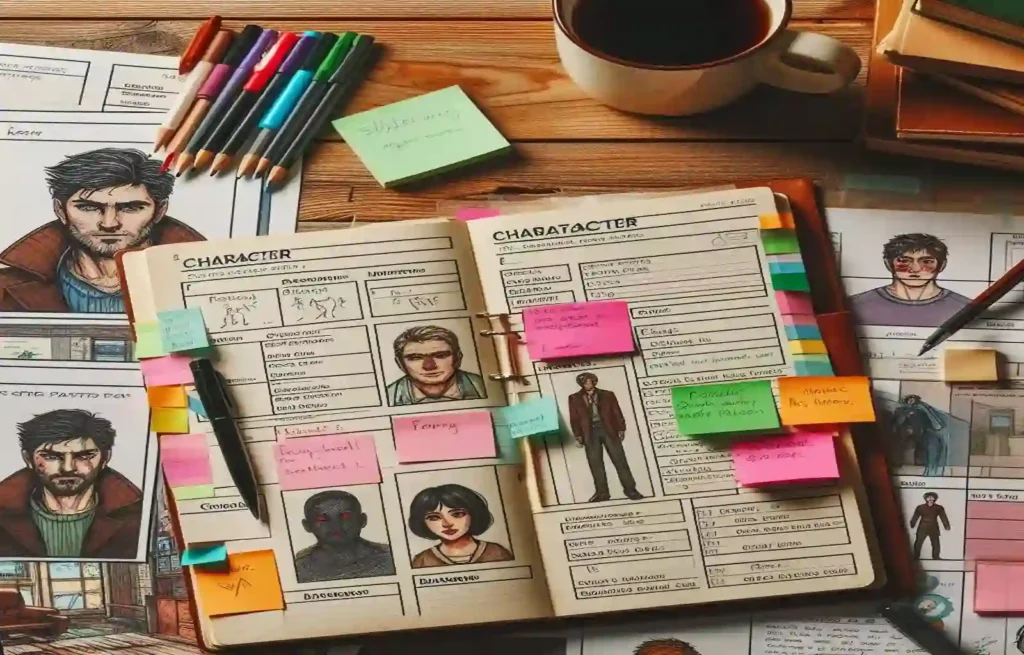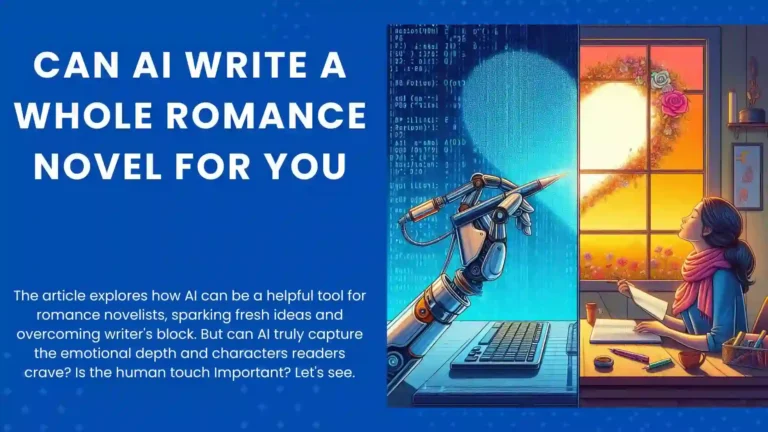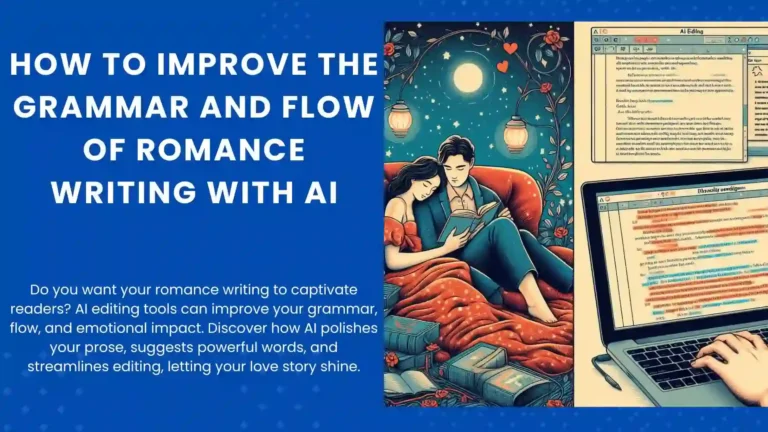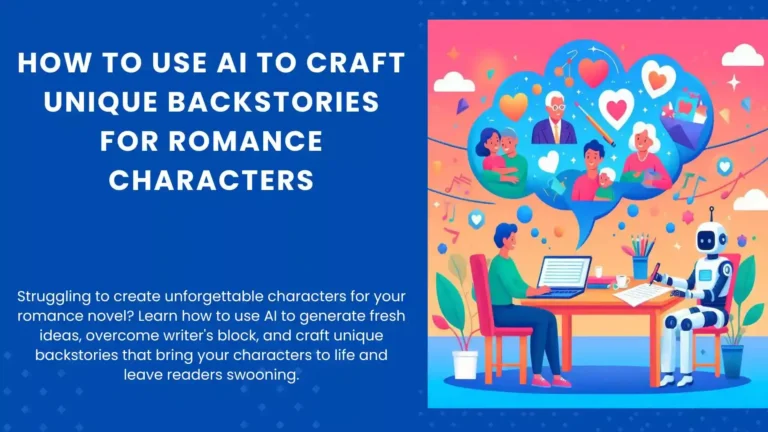Best Practices for Aspiring Authors: Mastering Romance Writing with AI

As a romance writer, you aim to craft unique and captivating tales of love that leave your readers craving more.
However, sometimes, even with all your passion and creativity, writer’s block can hit you hard, making it challenging to find the right words and ideas.
Thanks to the incredible advancements in AI technology, those days are now a thing of the past.
So, what exactly are these AI writing assistants, and how can they help you craft your next bestselling romance novel?
How best can you use these tools to spark fresh ideas, build captivating plots, and write conversations that sound real, all while keeping your own unique style?
Join me as I explore the best practices for romance writers using AI writing assistants, helping you apply them as tools, not as a replacement.
Key Takeaways:
- AI writing assistants can help romance writers improve creativity and overcome writer’s block by offering fresh ideas and suggestions.
- To get the most out of AI tools, craft specific prompts that guide the AI in generating content that is aligned with your vision.
- It’s okay to reject AI suggestions that don’t fit your story or characters. Trust your instincts and stay true to your vision.
- During editing and revision, ensure AI-generated content fits your style, maintains pacing, and keeps characters consistent.
- Getting feedback from beta readers or editors can help you identify areas for improvement and give you confidence in your writing.
Understanding AI Writing Assistants
Before exploring the right practices when using AI writing assistants, let’s first define these tools and their key features.
What are AI Writing Assistants?
They come in different shapes and sizes, each with its own specific use.

AI writing assistants are tools designed to make your writing smoother and more enjoyable.
Some, like grammar checkers, act as your personal proofreaders, catching those sneaky typos and ensuring your sentences are in tip-top shape. Examples include Grammarly, ProWritingAid, and Hemingway Editor.
Others, like paraphrasing tools, help you find new ways to express your ideas, giving your writing a fresh twist. QuillBot and Wordtune are good examples.
And then there are the creative writing assistants like Jasper, NovelCrafter, and Sudowrite; the ones that can help you generate captivating plots and characters in no time.
Key Features for Romance Writers
Let’s now dive into some key capabilities that make these tools a must-have for every love writer.
- Brainstorming – Whether you need help with plot points, character quirks, or steamy scene ideas, AI writing assistants can provide you with a variety of suggestions, sparking your creativity and helping you overcome writer’s block.
- Dialogue – AI writing tools can craft authentic, engaging conversations that fit specific situations or character dynamics, giving you a starting point to work with.
- Plot Outlining – Structuring a romance novel that keeps readers hooked from the first page to the last is not easy. AI tools can suggest plot points, help you develop a cohesive story arc, and ensure that your characters’ emotional journeys are satisfying and believable.
- World-building – AI storytelling tools can help you craft vivid settings, unique cultures, and an immersive backdrop for your love story, be it a small town, bustling city, or fantastical realm.
Best Practices for Romance Writers Using AI Writing Tools
Now that you understand the potential of AI-powered writing assistants, let’s explore how you can make the most of these tools to create a romance novel that will leave your readers breathless.
1. Pre-Writing Phase

The Pre-Writing Phase is an essential step in your writing process, as it lays the groundwork for a successful story.
It involves setting clear writing goals, researching romance genre trends, and creating detailed character profiles.
A. Set Clear Writing Goals
Setting goals is important as it guides you through the rest of the writing process.
First, who is your target audience?
Are you writing for young adults who crave a sweet, coming-of-age romance or a more mature crowd who appreciates a steamy, passionate tale?
Knowing your readers will help you tailor your story to their desires and expectations.
Next, consider the length of your romance novel.
Are you aiming for a short, sweet novella or an epic, slow-burn love story that spans hundreds of pages?
Having a target word count in mind will help you pace your plot and ensure that every scene counts.
Finally, consider the romance genre itself.
Examples include contemporary, historical, paranormal, and suspense.
Pinpointing the specific sub-genre you want to tackle will help you focus your story and deliver the tropes and elements that your readers crave.
B. Research Romance Genre Trends and Audience Preferences

Now that you’ve set your writing goals, it’s time to research what’s hot in the romance world and what your target audience loves.
Go through some popular romance books in your chosen subgenre. What tropes and themes are readers excited about? Are they craving for enemies-to-lovers stories or friends-to-lovers romances? Are they drawn to billionaire bad boys or small-town sweethearts?
You can also spend time browsing the romance section at your local bookstore or library. Read reviews, join online romance reader communities, and follow popular romance authors on social media.
Doing this will help you understand the current trends and preferences so you can easily incorporate the elements readers crave into your romance novel.
C. Create Detailed Character Profiles

As you know, the connection between your protagonists is what attracts readers to your love story and keeps them turning the pages.
But how do you create characters that feel like real people, with all their quirks and flaws?
The secret is in the details.
Before you start writing, take the time to create detailed character profiles for your main players.
You need to know everything about your characters, from their favorite ice cream flavor to their deepest fears and desires.
Start with the basics: age, appearance, occupation, and background. Then, dive deeper into their personalities. Are they introverted or extroverted? What are their hobbies, pet peeves, and guilty pleasures?
Next, dig into their motivations. What drives your characters? What are their goals, both in love and in life? Are they searching for their soulmate, or are they afraid of commitment?
Don’t forget about backstory, either.
Just like in real life, our pasts shape who we are and how we love.
Give your characters a history that influences their present. Did they have a painful breakup that left them guarded?
Did they grow up in a loving family that taught them the value of partnership?
By understanding your characters, you’ll know how they’ll respond in any given situation, enabling you to create a love story that feels authentic and compelling.
2. Writing Phase
This stage involves the actual writing of your romance novel. It is where you will utilize AI content generators as your helping tool.
A. Brainstorming and Idea Generation with AI

One way AI writing tools can help you is by generating fresh ideas you would never think of alone.
Let’s say you are stuck on what should happen next in your story. All you have to do is explain your story and where you are stuck to the AI, and it will offer suggestions and twists you never saw coming.
Or maybe you’re struggling to make your characters feel unique and memorable. Your AI writer can generate a list of quirky hobbies, hidden talents, or charming flaws that will make your characters real and relatable.
But here’s the best part – AI content creation tools don’t just spit out generic ideas.
They can be tailored to your specific needs and preferences, as we will see next about guiding the AI and crafting good prompts.
B. Crafting Effective Prompts

The key to getting the most out of an AI copywriting tool is crafting effective prompts to guide it in generating content that perfectly aligns with your story.
The clearer and more specific your prompts are, the better the AI can respond to your needs.
So, how can you write such a prompt?
Instead of simply telling the AI, “Write a love story idea,” try something like:
“Write a 300-word love story about two childhood friends, Emma and Jack, who reconnect at their high school reunion after 10 years apart. Show how they rekindle their friendship, realize their feelings for each other, and decide to give love a chance. Set the story at the reunion venue and include dialogue that reveals their emotions. Use a warm, nostalgic tone.”
This prompt includes key elements such as:
- The length of the story (300 words)
- The main characters and their backstory (Emma and Jack, childhood friends)
- The setting (high school reunion)
- The main plot points (rekindling friendship, realizing feelings, deciding to give love a chance)
- The desired tone (warm and nostalgic)
See the difference? By providing specific details about the setting, characters, and tone, you’re giving the AI a clear roadmap to follow.
Another tip is to use keywords that reflect the tone and style of your romance novel. If you’re writing a humorous romance, sprinkle in words like “witty,” “playful,” or “lighthearted” to guide the AI in the right direction. If you’re going for a suspenseful, dramatic vibe, try keywords like “mysterious,” “intense,” or “passionate.”
But here’s the thing – even the most well-crafted prompt might not yield perfect results on the first try.
If the AI gives you an idea that’s close but not quite right, just tweak your prompt and try again.
C. Leveraging Artificial Intelligence for Plot Development and Structure
As you know, every great love story needs a solid foundation.
Now, how do you turn ideas into a cohesive, well-structured story that will keep your readers hooked from the first page to the last?
AI can help.
One of the most powerful ways AI can assist with plot development is by helping you outline your story.
Your AI can suggest key plot points, like the inciting incident that brings your characters together, the first kiss that sparks their passion, and the black moment that threatens to tear them apart.
AI can also ensure that your story has a clear beginning, middle, and end, with a satisfying emotional arc for your characters.
For example, let’s say you’re writing a friends-to-lovers romance.
Your AI can help you map out the key moments in your characters’ relationship, from the initial spark of attraction to the first time they admit their feelings to the final, swoon-worthy declaration of love.
It can ensure that each scene builds on the last, creating a sense of momentum and anticipation that will keep your readers turning the pages.
D. Incorporating Emotional Depth and Authenticity in Dialogue
Picture this: your characters are having a heart-to-heart conversation, pouring out their deepest feelings and desires.
The words flow effortlessly, each line perfectly capturing the essence of their relationship. Your readers are hanging on every word, feeling the characters’ emotions as if they were their own.
That, my friend, is the power of authentic, emotionally charged dialogue.

But crafting dialogue that truly resonates can be a challenge.
That’s where your AI writing software comes in.
For example, you can ask your AI to generate a dialogue prompt like, “Character A confronts Character B about the secrets they’ve been keeping.”
From there, the AI might suggest lines like, “I thought we promised to always be honest with each other” or “Do you have any idea how much it hurts to find out you’ve been lying to me?”
To ensure that your dialogue has emotional depth and authenticity, you’ll want to take the AI’s suggestions and make them your own.
Infuse each line with your characters’ unique voices and personalities.
As you’re editing, ask yourself:
- Does this dialogue sound like something my character would actually say?
- Does it move the story forward or reveal something new about their relationship?
- Does the dialogue hint at deeper feelings or unspoken thoughts that your characters might be holding back?
One tip is to read your dialogue out loud, or even act it out with a friend. Listen to the rhythm and flow of the words, and make sure they sound natural and authentic.
3. Editing and Revision
One thing that can turn readers away from your book is encountering distractions along the way.
To keep them engaged, it’s crucial to ensure your writing flows smoothly and is free of grammar errors.
Wondering how AI can help with that?
Let’s find out.
A. Grammar and Style Checks with AI

Most AI writing assistants come with built-in grammar and style checkers that can help you generate content free of spelling errors, awkward sentence structures, and incorrect word choices.
Others, like Grammarly and ProWritingAid, analyze your writing and give suggestions on how to make it more engaging or concise, improving your writing style and making your prose shine.
For example, let’s say you tend to write overly long, complex sentences that confuse your readers.
Your AI might suggest breaking those sentences up into shorter, more impactful ones.
Or maybe you’ve used the same word or phrase a few too many times, and your AI can suggest some synonyms to add variety to your fiction writing.
B. Revising for Pacing and Tension
Okay, so you’ve gone through your story and fixed all the grammar mistakes.
Now, let’s talk about the secret ingredient that keeps your readers hooked: pacing and tension.
Think of your romance novel as a rollercoaster ride.

You want your readers to feel the excitement, the butterflies, and the thrill of falling in love right alongside your characters.
And how do you make that happen? By nailing your pacing and tension.
First, look at your story from start to finish.
Does it feel like the story is moving forward, building towards something big and exciting?
Or does it feel like you’re just going from one scene to the next without a clear point?
Look for parts where the story feels slow, where there’s not enough happening to keep your readers interested. Maybe there’s a scene that’s not really needed or a side story that’s not going anywhere. Don’t be afraid to cut, chop, and move things around until you’ve got a story that keeps readers turning the pages.
And then there’s tension – the secret sauce that turns an okay romance into a heart-pounding, hand-sweating page-turner. Tension is all about creating a feeling of excitement, of making your readers desperate to find out what happens next.
And how do you do that? You use conflict.
By conflict, I’m talking about the delicious tension that comes from two characters who are crazy attracted to each other but just can’t seem to get on the same page.
The kind of tension that comes from secrets, mix-ups, and roadblocks that keep your lovebirds apart.
As you’re editing, look for chances to turn up the tension. Maybe your heroine has a deep-down fear of commitment that’s keeping her from taking the leap with the hero.
Or maybe there’s someone else who’s after your hero’s heart and just won’t take no for an answer.
Whatever it is, make sure there’s always something keeping your readers on the edge of their seats, wondering how your characters are going to beat the odds and find their happily ever after.
C. Keeping Your Characters Consistent
You could have the most exciting plot in the world, but if your characters aren’t believable or don’t feel like real people with real thoughts and feelings, your readers will lose interest quickly.
So, how do you ensure your characters stay true to themselves from start to finish?
First, take a good look at your characters and ask yourself :
- Who are they, really?
- What makes them tick?
- What do they want, and what’s stopping them from getting it?
When editing with AI assistance, it’s your responsibility to ensure that your characters remain consistent throughout the story.
If your introverted, book-loving heroine abruptly starts behaving like an outgoing party enthusiast midway through the narrative, your readers will be confused.

Similarly, if your tough hero suddenly becomes emotional and bursts into tears at the first sign of trouble, readers may find it hard to believe.
In short, always check with your characters every step of your story and ask yourself: “Would this character really say/do/think this?”
4. Post-Writing Phase
You now have completed writing and refining your love story. What should you do next?
Let’s see!
A. Getting Feedback from Beta Readers and Editors
See, here’s the thing. You might think a certain scene is the most romantic thing ever written, but an outside reader finds it dull or unconvincing.
Or maybe there are plot holes in your story you didn’t even notice, but they are apparent to others.
That’s where beta readers and editors come in.
Beta readers are like your story’s test audience. They read your book with fresh eyes and give you their honest opinions.
They tell you what they loved, what they didn’t quite connect with, and where they got a little lost along the way.
You will then use their feedback to polish your story until it shines.
So, how do you find these magical beta readers?
Start by reaching out to your writing community.
You can join some online writing groups or attend local writing events. You’d be surprised how many fellow writers are happy to swap stories and give feedback.
You can also ask friends or family members who are romance readers to take a look.
Just make sure you choose people who will give you honest, constructive feedback, not just tell you what you want to hear.
You can also hire an editor (especially one specialized in the romance genre inside), although it can be a big investment.
The editor will review your story, fine-tune it, correct errors and inconsistencies, improve pacing, and strengthen your characters.
B. Fine-Tuning Your Manuscript Based on Feedback
Now, take your time and go through all the feedback you received from beta readers.
If multiple readers are pointing out the same issue, whether it’s a plot hole or a character that feels a little flat, that’s a good sign that it’s something you need to address.
But if it’s just one person’s opinion, and it doesn’t quite fit with your vision for the story, it’s okay to set it aside.
Conclusion: Essential AI Tips for Romance Writers
Mastering the best practices of using AI writing tools when creating romance novels offers you an unprecedented advantage in today’s world.
This helps you be more creative, overcome challenges, and produce captivating love stories that resonate deeply with readers.
To generate relatable AI-assisted love stories, craft effective prompts to guide your AI and infuse dialogue with emotional depth.
Also, remember to edit and revise AI-generated content to correct errors, maintain pacing, and ensure character consistency.
Moreover, use AI as a tool and not a replacement, as your unique voice, your passion for storytelling, and your understanding of your story are what matters the most.
Frequently Asked Questions (FAQs)
What are the different types of AI writing assistants?
AI writing assistants come in various forms, including grammar checkers, content generators, storytelling aids, and all-purpose writing tools. They utilize natural language processing and machine learning to enhance the writing process.
How do I find beta readers for my romance novel?
Look for online romance communities, like Facebook groups or forums. You can also target readers on your email list or social media who enjoyed your previous work.
What are some tips for editing a romance novel?
Focus on character development, pacing, and emotional depth. Edit for consistency in plot, dialogue, and tone. Consider feedback from beta readers and be willing to revise extensively for improvement.
How do I create effective prompts to get the most out of my AI writing assistant?
The key to strong prompts is clarity! Tell your AI assistant exactly what you want: content type (article, poem), target audience (teens, professionals), and desired tone (funny, informative). The more details you give, the better it writes for you!
Can AI help me with editing and revising my romance novel?
Yes, AI can assist with editing and revising your romance novel by offering grammar suggestions, detecting repetitive phrases, and providing insights on readability and style. However, human input remains crucial for final polishing.






